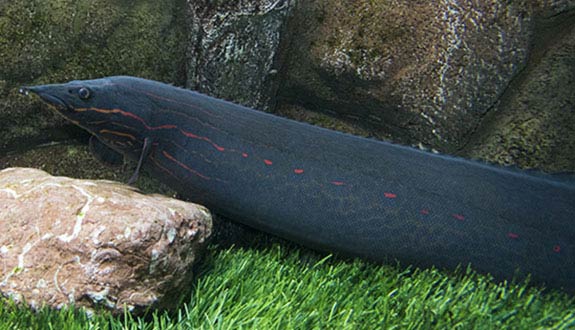

Alternative species (click on the thumbnail to see the card)
Names
Scientific name
Mastacembelus erythrotaenia
Common name
Fire eel
Origin

Origin: Asia, Thailand, Indonesia
Biotope: Asian
Dimorphism

None
Group

Mastacembelidae
Volume

400 L / 88 imp gal / 106 US gal
Parameters

T°: 24 to 28°C or 75 to 82°F
pH: 6.8 to 7.5
Hardness: 8 to 25°dGH
Difficulty

Hard
Size

100cm (39.4")
Longevity

10 years
Living zone

Depth
Individuals

1
Food
How to feed the Fire eel?
Food
How to feed the Fire eel?
This carnivorous eel enjoys everything that passes in front of it. Its favourite dishes are mussels, shrimps, larvae and worms.
With patience and gentleness, you can get him used to coming to get his food at your fingertips.
Behavior
What kind of behavior does the Fire eel have?
Behavior
What kind of behavior does the Fire eel have?
The Mastacembelus spends most of its time scouring the ground in search of food. The rest of the time he spends it hidden away from the light. In fact, if he spends too much time hiding, it's probably because there's too much light for his taste. Don't hesitate to lower the general brightness of the aquarium to make him more comfortable.
Cohabitation
Who can live with the Fire eel?
Cohabitation
Who can live with the Fire eel?
Inter-species cohabitation generally goes very well. However, the older they get, the stronger their character becomes. To avoid conflicts, a large space of at least 400 L / 88 imp gal / 106 US gal should be provided for each specimen.
Beware of cohabitation with other species. Indeed, considering its hunting instinct and its size, anything too small will one day end up in its belly. Some aquarists report successful cohabitations with Dawkinsia filamentosus, Barbodes lateristriga, Oscar fish or even with large cichlids.
Breeding
How to breed the Fire eel?
Breeding
How to breed the Fire eel?
Impossible in amateur aquarium hobbyists because of the huge volumes involved in the breeding process.
Its aquarium
Which aquarium for the Fire eel?
Its aquarium
Which aquarium for the Fire eel?
When it is offered in the trade, this eel is very young and very small. But beware, its adult size can be up to 1 meter (39.4")! You need an aquarium of at least 400 L / 88 imp gal / 106 US gal (and we are talking about a strict minimum here) to start doing things right. You will have to add to this volume 400 L / 88 imp gal / 106 US gal for each additional eel.
As it grows at the bottom of the aquarium, it is essential to provide this species with a floor made of fine sand and solid elements such as inverted flower pots.
The filtration will have to be external because it will have to be quite powerful given the eel's activity: it digs into the sand and buries itself in it, which throws out a lot of particles that end up in suspension. Thus, we recommend a flow rate per hour of at least 3 to 4 times the volume of the tank.
Good To know
Find all additional information!
Good To know
Find all additional information!
The Mastacembelus erythrotaenia has beautiful colours: the body is dark brown, the back is rather grey/brown. The coat is completed by spots of different colours. Did you know that these spots change colour depending on the age of the fish? Indeed, they are rather yellow when the eel is young and red in older individuals.
Yours photos!
Comments
Sort by:
Please login to post comments

